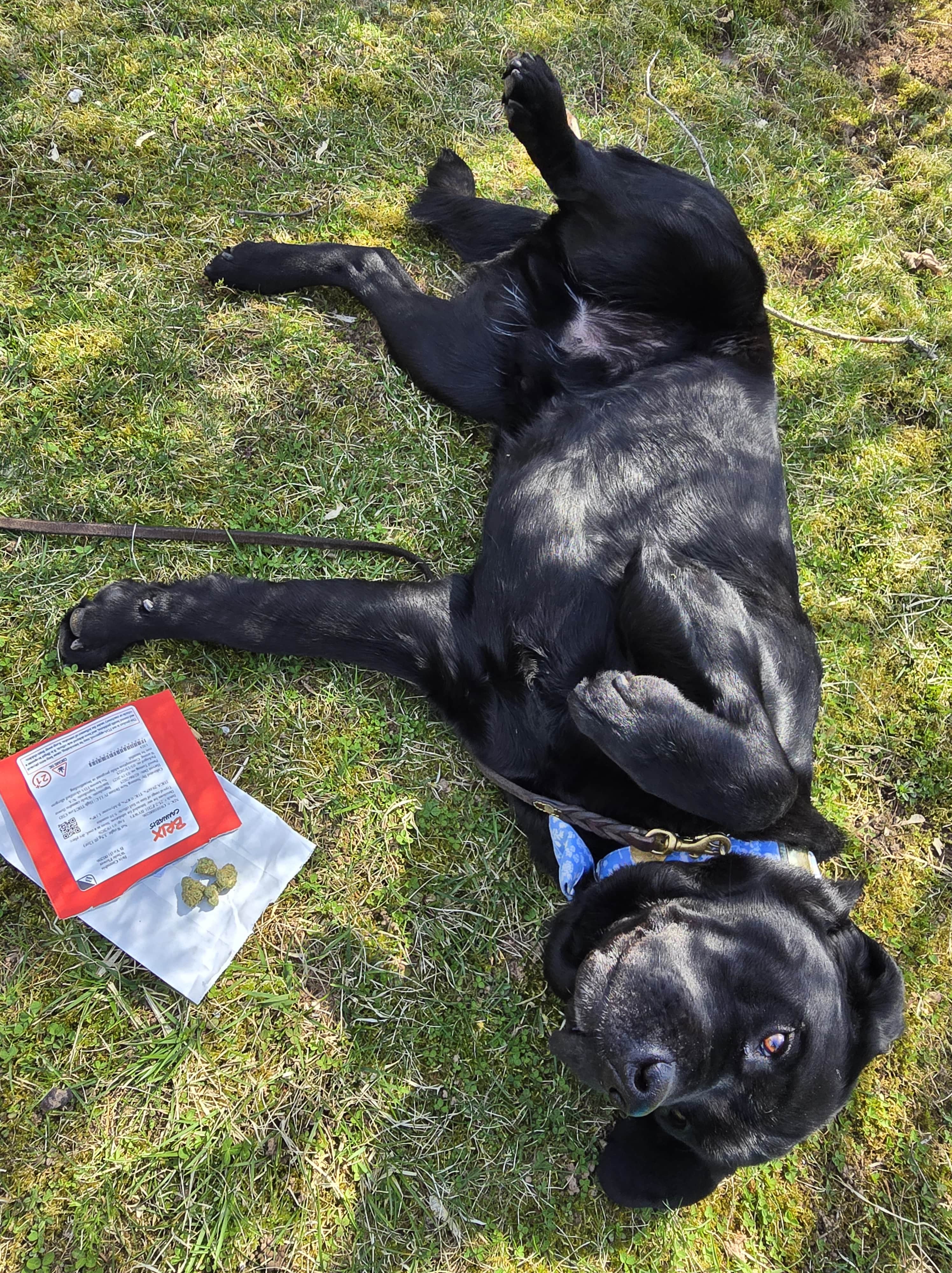-
Adopt
-
Veterinary Care
Services
Client Information
- What to Expect – Angell Boston
- Client Rights and Responsibilities
- Payments / Financial Assistance
- Pharmacy
- Client Policies
- Our Doctors
- Grief Support / Counseling
- Directions and Parking
- Helpful “How-to” Pet Care
Online Payments
Emergency: Boston
Emergency: Waltham
Poison Control Hotline
-
Programs & Resources
- Careers
-
Donate Now
![]()
 By Michael Gay, DVM
By Michael Gay, DVM
angell.org/emergency
emergency@angell.org
617-522-7282
April 2025
x
x
x
With the legalization of marijuana in recent years, the product itself, in all its various forms, has become more readily available. In the human world, it is a drug that is used for both medicinal and recreational purposes. At present, pets are exposed to marijuana through accidental ingestion or inhalation of human products or being administered products made for pets. With the increased use of marijuana in humans, there has been a corresponding rise in pets, primarily dogs, being unintentionally exposed to marijuana. Additionally, there has been a surge in the number of products available for medicinal use in pets. Although there are reports of owners accidentally administering an overdose of a marijuana product to their pet for medicinal purposes, most cases associated with clinical signs are due to accidental exposure. In addition to dogs, cats, ferrets, birds, and iguanas can be affected by marijuana. The safe therapeutic dose for pets has not yet been determined.
pets are exposed to marijuana through accidental ingestion or inhalation of human products or being administered products made for pets. With the increased use of marijuana in humans, there has been a corresponding rise in pets, primarily dogs, being unintentionally exposed to marijuana. Additionally, there has been a surge in the number of products available for medicinal use in pets. Although there are reports of owners accidentally administering an overdose of a marijuana product to their pet for medicinal purposes, most cases associated with clinical signs are due to accidental exposure. In addition to dogs, cats, ferrets, birds, and iguanas can be affected by marijuana. The safe therapeutic dose for pets has not yet been determined.
The effects of marijuana on our pets are due to two metabolites of the drug: tetrahydrocannabinol (THC) and cannabidiol (CBD). These compounds are initially processed through your pets’ liver and then, due to their lipophilic (i.e., “fat-loving”) nature, they are distributed to CB1 and CB2 receptors throughout the body, which are most prevalent in the brain. This mechanism of metabolism means that there is a delay between marijuana ingestion or inhalation and the onset of clinical signs, typically an average of 75 minutes from the time of exposure, but up to 12 hours. The metabolism mechanism also means a longer duration during which pets may be under the influence.
Clinical signs of marijuana ingestion in dogs include: suddenly losing coordination when walking; dribbling urine; tremors; and sleepiness, with sudden arousal or agitation. More severe signs, such as seizures or a loss of consciousness, may be noted at higher doses. Vomiting is the sign most often seen in cats.
When such a pet arrives at a veterinary hospital, a veterinarian will initially perform a physical exam. A veterinarian will document the dog’s clinical signs and recognize abnormalities on physical exam, such as dilated pupils, rapid eye movement, low heart rate, and low body temperature. Typically, a diagnosis of marijuana ingestion in a dog is made based on the clinical signs and physical exam findings. The gold standard diagnostic tool for diagnosing marijuana ingestion in pets is gas chromatography. This test must be sent to an outside lab, which takes several days to receive results.
Therefore, it is seldom used in clinical practice. Human urine drug tests may be used to evaluate for marijuana toxicity in dogs, but many factors may lead to a false negative result. Dogs do not develop the same marijuana metabolites as humans; therefore, the presence of the drug may not be detected in a dog’s urine. In addition, certain medications, such as a non-steroidal anti-inflammatory pain medication (e.g., Deramaxx, Meloxicam, Rimadyl), Vitamin B2, and some anti-viral drugs, interfere with the accuracy of the urine test. Cats produce some of the same metabolites as humans and are more likely to have a positive result when using a human urine test kit. However, obtaining the amount of urine necessary to conduct the test from a cat may be difficult. A veterinarian may do additional diagnostics, such as bloodwork, radiographs, urinalysis, and blood pressure, to rule out other potential causes of the pet’s clinical signs. Overall, a pet’s clinical signs and physical exam findings, in combination with known or potential exposure to marijuana, and the exclusion of other conditions, are used to arrive at a diagnosis of marijuana toxicity.
Once a veterinarian has determined that a pet is suffering from marijuana toxicity, they will determine the ideal treatment for the pet. In many types of toxicity, inducing vomiting and administering activated charcoal are the primary means of decontamination. However, in the case of marijuana toxicity, the efficacy of these methods is minimal unless the ingestion was known to have occurred less than an hour before presentation. More often, a veterinarian recommends a treatment strategy based on the severity of the pet’s clinical signs. Most dogs have mild clinical signs and can be treated on an outpatient basis. Outpatient treatment includes administration of subcutaneous (under the skin) fluids and an antivomiting medication. Pets with more severe clinical signs are admitted to the hospital for more intensive treatment. Due to how marijuana is metabolized in dogs, the duration of time that the drug causes clinical signs is much longer in pets than in humans. Accordingly, dogs who are significantly affected by marijuana need to remain in the hospital until their clinical signs improve. In-hospital treatment consists of administering intravenous fluids, blood pressure monitoring, heat support, intravenous anti-vomiting medications, intravenous muscle relaxants, and, if necessary, anti-seizure medications. In the most serious cases, intravenous lipid emulsion therapy is administered.
In general, the prognosis for pets who have ingested marijuana is good. Nevertheless, there are rare cases of patients passing away due to respiratory arrest, uncontrollable seizures, coma, and aspiration pneumonia. It is essential to realize that although there are marijuana products available for pets, we do not yet know the margin of safety for this drug in our pets, and the content of marijuana in these products varies. The prevalence of marijuana products means that pet owners must ensure that these products are not accessible to pets, be careful when administering these products to pets, and seek veterinary care as soon as possible if your pet unintentionally ingests or inhales these products.
x
References
- Amissah RQ, Vogt NA, Chen C, Urban K, Khokhar J. Prevalence and characteristics of cannabis-induced toxicoses in pets: Results from a survey of veterinarians in North America. PLoS One. 2022;17(4):e0261909.
- Binagia EM, Gregory EA, Yankin I. Clinical examination findings and electrolyte abnormalities of dogs with marijuana/tetrahydrocannabinol toxicity: 223 cases (January 2017-July 2021). J Am Vet Med Assoc. 2024;262(8):1047-1054.
- Fitzgerald KT, Bronstein AC, Newquist KL. Marijuana poisoning. Top Companion Anim Med. 2013;28(1):8-12.
- Gyles C. Marijuana for pets? Can Vet J. 2016;57(12):1215-1218.
- Janeczek A, Zawadzki M, Szpot P, Niedzwiedz A. Marijuana intoxication in a cat. Acta Vet Scand. 2018;60(1):44.
- Kulpa JE, Paulionis LJ, Eglit GM, Vaughn DM. Safety and tolerability of escalating cannabinoid doses in healthy cats. J Feline Med Surg. 2021;23(12):1162-1175.
- Wismer T. Marijuana intoxication in cats and dogs. Today’s Veterinary Practice. ********todaysveterinarypractice.com/toxicology/marijuana-intoxication-in-cats-and-dogs/. Published March/April 2024. Accessed April 17, 2025.